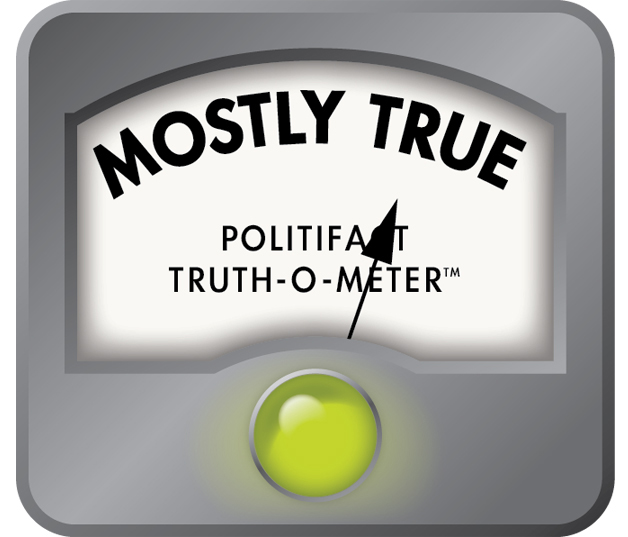Get PolitiFact in your inbox.
President Donald Trump delivered the 2019 State of the Union address on Feb. 5, 2019, addressing the topics of the economy, immigration, foreign policy and more.
Here are some of his comments, fact-checked or with additional explanation or context. This report includes information on three accurate statements and 12 claims that are inaccurate, exaggerated or lack context.
We've also fact-checked the Democratic response delivered by Stacey Abrams, a 2018 candidate for Georgia governor.
(This report was last updated Feb. 11, 2019.)
IMMIGRATION
"In the past, most of the people in this room voted for a wall — but the proper wall never got built. I will get it built."
This lacks context. The Secure Fence Act of 2006 authorized 700 miles of southwest border fencing, but it was different from the wall Trump promised to build on the campaign trail.
The 2006 law earned the support of just over half of Senate Democrats, including Minority Leader Chuck Schumer. But many House Democrats, including current Speaker Nancy Pelosi, voted against it.
Trump initially said his wall would be made of "hardened concrete," as tall as "95 stories" with a "very big, very beautiful door." (He now promotes a see-through barrier of slats.) Trump derided the 2006 fence as too modest during the 2016 campaign — he said it was a "little fence" that could be scaled with a ladder.
— Amy Sherman
"Year after year, countless Americans are murdered by criminal illegal aliens."
We can’t specifically document how many U.S. citizens have been killed, because there is no national database on murders committed by immigrants in the country illegally. There also is no national data or study tracking the nationality of the victims, experts have also told us.
And while some immigrants here illegally have committed murders, research indicates that immigrants are less likely to engage in criminal behavior than the native-born population.
— Miriam Valverde
"One in three women is sexually assaulted on the long journey north."
This is Half True. The number isn’t necessarily representative of the entire migrant population traveling through Mexico.
The number comes from a 2017 Doctors Without Borders report. The report found that 31.4 percent of women had been sexually abused during their transit through Mexico. That 31.4 percent figure came from a 2015 survey of more than 400 migrants in shelters and other places where migrants seek help. (The majority of people surveyed were men.)
Doctors Without Borders said its report provided a "snapshot in time," drawing from a population that was accessible to the medical group.
— Miriam Valverde
"In the last two years, our brave ICE officers made 266,000 arrests of criminal aliens, including those charged or convicted of nearly 100,000 assaults, 30,000 sex crimes, and 4,000 killings or murders."
The numbers needs context, for several reasons.
A single person could have committed multiple crimes; the tally includes people charged, and a charge doesn’t mean that a person is guilty; the most common crimes for which immigrants were charged or convicted were traffic, drugs, and immigration law violations.
— Miriam Valverde
"The border city of El Paso, Texas, used to have extremely high rates of violent crime — one of the highest in the country, and considered one of our nation's most dangerous cities. Now, immediately upon its building, with a powerful barrier in place, El Paso is one of the safest cities in our country."
We rated this claim False. Crime data shows that El Paso has not been one of the most dangerous cities in the nation. From 1985 to 2014, El Paso’s violent crime rate was significantly lower than the average for cities of comparable size.
Border authorities added fencing in the El Paso region in the late 2000s. In the immediate years before and after construction, the violent crime rate went up, contrary to Trump’s claim.
Even though the violent crime rate went up after the fencing, that doesn’t necessarily mean that the fence caused the spike, said Charis E. Kubrin, a criminologist at the University of California-Irvine. Likewise, if the violent crime rate had gone down, it’s improper to say it was just because of the fencing, she said.
— Miriam Valverde
"San Diego used to have the most illegal border crossings in our country. In response, a strong security wall was put in place. This powerful barrier almost completely ended illegal crossings."
PolitiFact California rated this statement Half True. He’s right that border patrol arrests have plunged, declining 96 percent along the San Diego sector, from 1986 to 2017. The biggest drop took place in the late 1990s, after a triple-layer barrier replaced an initial fence built in 1993. But experts on the border, along with a congressional report, show San Diego’s border fence was only one factor in helping reduce the crossings. A surge of border patrol agents, vehicles and technology along with improved economic opportunities in Mexico all played important roles.
— Chris Nichols
ECONOMY
"All Americans can be proud that we have more women in the workforce than ever before."
This is wrong. It’s also not very meaningful: Just counting the number of women (or men, or both) who are in working, or are in the labor force, is driven by the size of the population, which is typically growing over time.
A better measure is the civilian labor force participation rate for women, which refers to the percentage of women who are either working or looking for work. The rate has been rising since late 2015, but the level for that today — 57.5 percent — is below what it was from about 1995 to the Great Recession, when it was typically in the 59 percent to 60 percent range.
Looking at sheer numbers, both the number of women who are employed and the number of women who are in the labor force (meaning they’re working or looking for work) dropped modestly during the most recent month for which data is available — December 2018 to January 2019. Women’s employment fell from 73.9 million to 73.6 million, while women in the labor force fell from 76.8 million to 76.7 million.
— Louis Jacobson
"Wages are rising at the fastest pace in decades."
Wages are indeed rising, but they began their upward trajectory under President Barack Obama, and wages actually rose a bit faster under Bill Clinton and George W. Bush.
One common measurement of wages is median usual weekly real earnings for full-time wage and salary workers 16 years and older, an inflation-adjusted figure.
During Trump’s presidency, this figure has risen from $351 to $355, an increase of 1.1 percent over the better part of two years.
But the current wage increase began in earnest in the second half of 2014, when Obama was still more than two years away from leaving the White House. Overall, wages increased by 7.5 percent over that period, from $330 to $355.
This rise in wages wasn’t as steep as the country saw in the 1990s. Between the fourth quarter of 1997 and the first quarter of 2002, wages rose from $314 to $341, an increase of 8.6 percent.
— Louis Jacobson
"Here, in the United States, we are alarmed by the new calls to adopt socialism in our country. America was founded on liberty and independence and not government coercion, domination, and control."
This is a variation on misleading attacks Republicans repeatedly made on Democrats during the 2018 midterms.
The narrowest definition of socialism is where the state owns all the means of production. Democrats have not called for the government to take over business.
American politicians such as U.S. Sen. Bernie Sanders, I-Vt., or U.S. Rep. Alexandria Ocasio-Cortez, D-N.Y., have used the term to call for a dramatic expansion of the social safety net, including already available health care programs. They typically propose much higher tax rates to pay for the programs.
That resonates with the systems in place in Europe, not Venezuela.
— Amy Sherman
"African-American, Hispanic-American and Asian-American unemployment have all reached their lowest levels ever recorded."
This was accurate in 2018 but is out of date. Unemployment levels for each group reached record lows under Trump’s watch.
African-American unemployment fell to a record of 5.9 percent in May, and is at 6.8 percent as of January. Asian unemployment fell to 2.0 percent in May, and is now at 3.2 percent. Hispanic unemployment reached 4.4 percent in December 2018, and is now at 4.9.
But these trends began under former President Barack Obama, and economists say presidents don’t deserve either full credit or full blame for the unemployment rate on their watch.
— Manuela Tobias
"Nearly 5 million Americans have been lifted off food stamps."
The number has fallen significantly, but Trump exaggerated the scale somewhat.
A net 4.6 million Americans left the food stamp program between Trump’s election and the most recent month available, September 2018, which is how the White House framed it in a pre-address information sheet.
It’s lower if you start counting in January 2017, when Trump actually took office — 4.1 million.
— Louis Jacobson
"We have created 5.3 million new jobs and importantly added 600,000 new manufacturing jobs."
Trump is close on overall job creation but less accurate on manufacturing jobs.
The United States has added 5.3 million jobs since Trump was elected in November 2016. Counting from when he took office in January 2017 makes the figure a bit smaller, at 4.9 million.
As for manufacturing jobs, the number rose from about 12.4 million in January 2017 to 12.8 million in January 2019, or an increase of 454,000. We should add that the increase in manufacturing jobs under Trump followed a rise under Obama that began in 2010, when the worst of the Great Recession had passed.
— Louis Jacobson
HEALTH CARE
"It is unacceptable that Americans pay vastly more than people in other countries for the exact same drugs, often made in the exact same place."
This is generally accurate.
In 2015, Bloomberg compared the prices, after discounts, of eight common medications. All but one cost substantially more in the United States. For example, the cholesterol-lowering pill Crestor cost $86.50 in the United States but cost $40.50 in Germany. An Advair asthma inhaler cost $154.80 in America, but it cost $74.12 in Canada.
The International Federation of Health Plans found similar disparities in its 2015 drug pricing report.
— Jon Greenberg
ABORTION
"Lawmakers in New York cheered with delight upon the passage of legislation that would allow a baby to be ripped from the mother's womb moments before birth."
This distorts the circumstances covered by the law signed Jan. 22 by New York governor Andrew Cuomo.
Previously, women in New York could only get abortions after 24 weeks of pregnancy if their lives were threatened. Under the new law, women can also get an abortion after 24 weeks if their health is threatened or the fetus isn’t viable.
The law codifies for New York the same standards established by the 1973 Roe vs. Wade decision.
Jen Villavicencio, an ob-gyn in the Midwest who provides abortions, told PolitiFact recently that late-term abortions are rare and usually due to medical crises. The Guttmacher Institute and the Centers for Disease Control and Prevention both report that slightly more than 1 percent of all abortions occur after 21 weeks.
"Abortions are not performed at 40 weeks on healthy, viable pregnancies," Villavincencio said. "Overwhelmingly, abortions that occur at this point in pregnancy are pregnancies where lethal fetal anomalies have been diagnosed."
— Jon Greenberg and Ciara O’Rourke
"We had the case of the governor of Virginia where he basically stated he would execute a baby after birth."
In an interview with a Washington radio station, Gov. Ralph Northam, a pediatric neurosurgeon, talked about what would happen if doctors determined that a woman in labor carried a child that was nonviable or severely deformed.
"The infant would be delivered," Northam said. "The infant would be kept comfortable. The infant would be resuscitated if that's what the mother and the family desired. And then a discussion would ensue between the physicians and the mother."
The proposed law would lift a current mandate that at least three doctors agree that a third trimester abortion is necessary for the protection of the mother's physical or mental health.
— Jon Greenberg
ENERGY
"We have unleashed a revolution in American Energy – the United States is now the number one producer of oil and natural gas anywhere in the world."
This is mostly accurate. The United States ranks first in both, but that’s only new for crude oil.
In 2017, the United States ranked first in the total production of petroleum and other liquid fuels as well as natural gas. Within the subset of crude oil production, the United States edged past Russia and Saudi Arabia in the summer of 2018, according to the Energy Information Administration, the federal office that collects energy statistics.
But the United States has been the world’s largest oil producer since 2012, and the largest natural gas producer for years.
— Manuela Tobias
"And now for the first time in 65 years we are a net exporter of energy."
That is on track to happen by 2020.
Being a net exporter means that, on an annual basis, exports exceed imports for all energy types. That has not been the case in the United States since 1953. That is projected to change in the next year, according to the U.S. Energy Information Administration.
Becoming a net exporter hinges on increasing natural gas and oil exports. The United States has for decades exported more coal than it imports. It only began exporting more natural gas than it imports in 2017, and the country still imports more petroleum and other liquids than it exports.
"We are very close," said Jason Bordoff, who directs Columbia University’s Center on Global Energy Policy. "It was true for one week in November, and will be occasionally for a week here or week there. On an annual basis, we will be a net exporter of energy in 2020."
— Manuela Tobias
FOREIGN POLICY
"For years, the United States was being treated very unfairly by friends of ours, members of NATO — but now over the past couple of years, we have secured a $100 billion increase in defense spending from NATO allies."
This could be true two years from now.
NATO secretary general Jens Stoltenberg said that’s what the European members expect to spend, and he credited Trump's "clear message."
"By the end of next year, NATO allies will add 100 — 100 billion extra U.S. dollars for defense," Stoltenberg said on Fox News Jan. 27.
In constant dollars, NATO member defense spending has gone up about $24 billion since 2016. In current dollars, the amount is $48 billion. While we don’t know Stoltenberg’s starting point, $100 billion requires a steep rise, and we won’t know if it comes true until many months from now.
— Jon Greenberg
THE DEMOCRATIC RESPONSE
Stacey Abrams: Today, "wages struggle to keep pace with the actual cost of living."
This is contradicted by data. By the official statistics — which are geared to capture the most typical scenario — wages are rising faster than inflation.
The primary statistic for measuring wages is median usual weekly real earnings for full-time wage and salary workers, age 16 and up. "Real" is economic-speak for "inflation-adjusted," so if the figure is rising over time, then wages are more than keeping pace with inflation. Data exists for the past four decades.
Over that four-decade span, median wage growth has hardly been robust — workers experienced a gain of 6 percent above inflation. But it did exceed inflation.
And the increase has been particularly clear since 2014, when wages finally began climbing again after losses during the Great Recession. Between the second quarter of 2014 and the fourth quarter of 2018, inflation-adjusted wages rose by almost 8 percent, the data show.
Another measurement — average weekly earnings of private-sector production and nonsupervisory employees, adjusted for inflation — shows a similar picture, with wages up in both the shorter and the longer term.
There are often subjective reasons people feel like wages aren't keeping up, such as big price increases being more noticeable or because their specific experiences differ. (We explore this phenomenon in more depth in a separate report.)
— Louis Jacobson
Stacey Abrams: "This administration chooses to cage children and tear families apart."
This requires more explanation.
In April 2018, Attorney General Jeff Sessions announced a "zero-tolerance" policy, meaning every person caught crossing the border illegally would be referred for federal prosecution, including adult migrants traveling with children.
After facing criticism, Trump signed an executive order June 20 to temporarily keep families together pending proceedings.
Abrams’ spokeswoman pointed to an AP article by a reporter who visited a facility where children were detained in McAllen, Texas. The reporter described seeing hundreds of children "in a series of cages created by metal fencing. .. Scattered about are bottles of water, bags of chips and large foil sheets intended to serve as blankets.
While Democrats called the facilities "dog kennels," the Department of Homeland Security said it used barriers to separate minors of different genders and age groups. Government handout images and a video show immigrants behind metal fencing.
Some viral photos spread by Trump critics were misleading. For example, one of the photos was from 2014, during the Obama administration. It showed detained children lying on mats on the ground in a holding cell. Another viral image wasn't of a child in U.S. custody. The child in that photo was in an open-topped enclosure temporarily erected for a June 2018 Texas protest of the separation of children from parents.
— Amy Sherman
Stacey Abrams: "Maternal mortality rates show that mothers, especially black mothers, risk death to give birth."
This is accurate.
Women in the United States are more likely to die from childbirth or pregnancy-related causes than women in other developed countries, and half of pregnancy-related deaths are preventable, according to the Centers for Disease Control and Prevention. High mortality rates among black women drive that statistic.
Between 2011 and 2014, the last years for which CDC statistics are available, about 12 white women died for every 100,000 that gave birth. For black women, the ratio jumps to 40 deaths.
While the causes of death are not entirely understood, socio-economic status and geography are tied to a mother’s chance of dying. And for black women, those problems are swelled by biases embedded in the medical system, as journalists at NPR and ProPublica have documented.
— Manuela Tobias
Our Sources
See fact-checks linked in the text.
PolitiFact, Did the United States recently become the No. 1 energy producer in the world? , Oct. 4, 2018
Energy Information Administration, international data home page, accessed Feb. 5, 2019
Energy Information Administration, "The United States is now the largest global crude oil producer," Sept. 12, 2018
Federal Reserve Bank of St. Louis, Unemployment Rate: Black or African American, accessed on Feb. 5, 2019
Federal Reserve Bank of St. Louis, Unemployment Rate: Asian, accessed on Feb. 5, 2019
Federal Reserve Bank of St. Louis, Unemployment Rate: Hispanic or Latino, accessed on Feb. 5, 2019
Email interview with Jason Bordoff, director of Columbia University’s Center on Global Energy Policy., Feb. 5, 2019
Email interview with Anna Mikulska, nonresident fellow in energy studies for the Center for Energy Studies at Rice University's Baker Institute for Public Policy, Feb. 5, 2019
U.S. Energy Information Administration, The United States is expected to export more energy than it imports by 2020, Jan. 29, 2019
PolitiFact, No, New York abortion law doesn't let mothers abort babies a minute before they would be born, Feb. 1, 2019
Bloomberg, The U.S. Pays a Lot More for Top Drugs Than Other Countries, Dec. 18, 2015
CDC, Pregnancy-Related Deaths, May 9, 2018
CDC, Pregnancy Mortality Surveillance System, Aug. 27, 2018
Review to Action.org, Report from Maternal Mortality Review Committees, Jan. 20, 2017
Associated Press, "Hundreds of Children Wait in Border Patrol Facility in Texas," June 18, 2018
Interview, Caitlin Highland, Stacey Abrams spokeswoman, Feb. 5, 2019

 PolitiFact Rating:
PolitiFact Rating: 
 PolitiFact Rating:
PolitiFact Rating:  PolitiFact Rating:
PolitiFact Rating:  PolitiFact Rating:
PolitiFact Rating:  PolitiFact Rating:
PolitiFact Rating:  PolitiFact Rating:
PolitiFact Rating:  PolitiFact Rating:
PolitiFact Rating:  PolitiFact Rating:
PolitiFact Rating:  PolitiFact Rating:
PolitiFact Rating:  PolitiFact Rating:
PolitiFact Rating:  PolitiFact Rating:
PolitiFact Rating:  PolitiFact Rating:
PolitiFact Rating: 
 PolitiFact Rating:
PolitiFact Rating: 






































